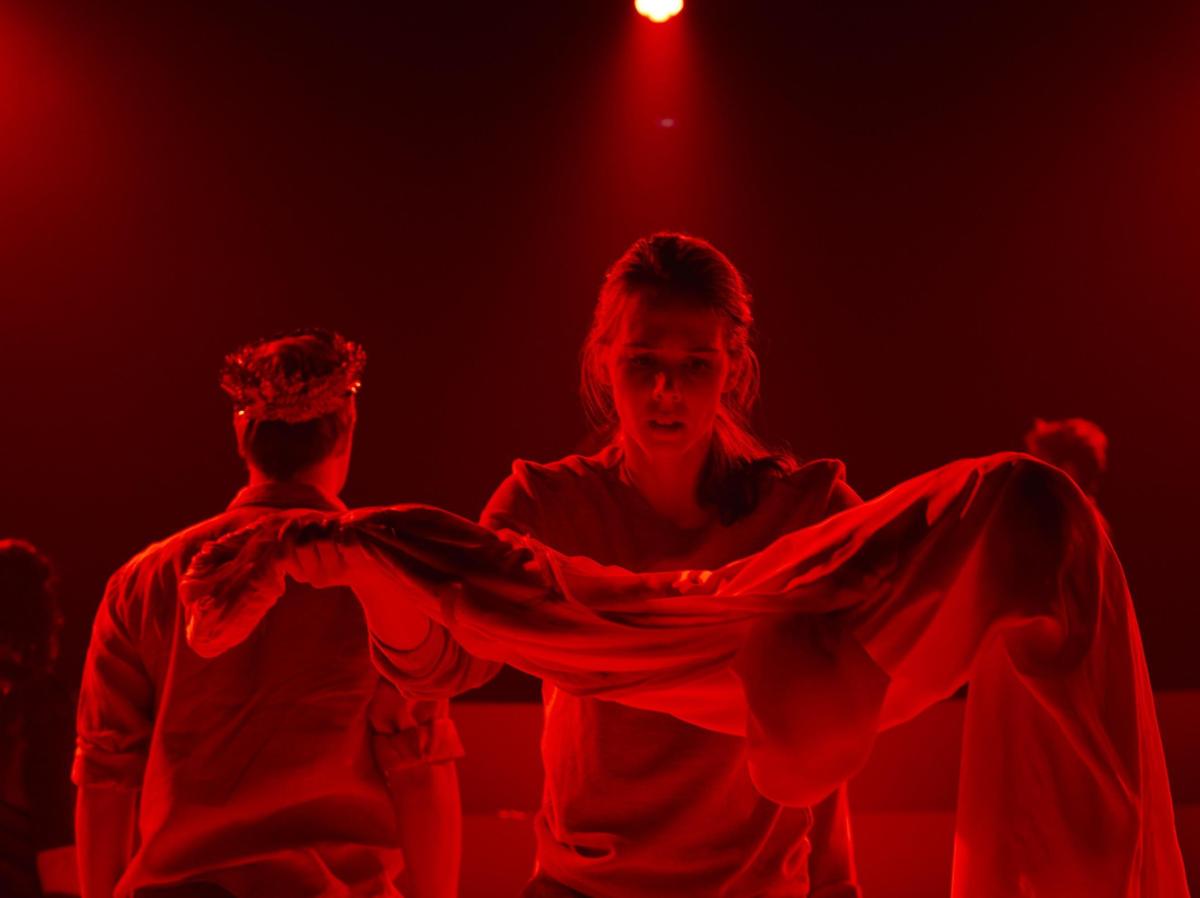Anna Dowsley in The Rape of Lucretia, Sydney Chamber Opera, Carriageworks. Photograph Zan Wimberley.
There are many valid reasons why The Rape of Lucretia, Benjamin Britten’s first chamber opera, is so rarely seen on stage. It has an awkward dual narrative structure, an overly-ambitious dramatic intent, and an almost undeliverable libretto by Ronald Duncan. Did burly soldiers really sit around the campfire trading florid insults such as ‘Lewd licentious lout!’ and ‘Pagan dyspeptic pig!’ on a cold night in Rome?
This new production of Lucretia by Sydney Chamber Opera and Victorian Opera takes place on a stark white amphitheatre set and opens with all eight singers on stage in casual clothing. There is no overture from the 13-piece orchestra, so it’s straight into the singing and the action. There are six characters carrying the story which is set in ancient Rome. It’s the year 509BC and Rome is ruled by the unpopular Etruscans. The other two parts are designated male and female chorus. These narrators are outsiders, viewing the action from another time and place, and overlaying it with a Christian conscience.
The story itself is relatively simple: the menfolk are away at war, leaving their wives behind. Their bawdy banter reveals that Lucretia, wife of Collatinus, is the only one believed to be truly faithful. This is the only inducement needed by Tarquinius, Prince of Rome, to prove she is a whore like all the others. The title act takes place and Lucretia, consumed with guilt and shame, kills herself even as Collatinus declares his love. This is all classic operatic fare, with its obvious themes of love and fidelity, power and oppression, class and morals. These themes are as relevant today as they ever were. But Britten wanted to say and do more, adding an ethnographic narration and overtly Christian symbology with its promises of redemption and life everlasting. Like so much opera, Lucretia confronts the fundamental questions of the human experience.
This production adds yet another layer of complexity and confusion as the six character singers engage in a game of gender switching. Whilst the female parts are still sung in the female voice, the male singers inhabit the characters, acting the roles and miming the words. This is a neat little piece of artistic invention, and a nice twist on opera’s general obsession with gender-bending (it’s my wife, dressed as a man, pretending to be a woman and so forth) but it’s really a one-line joke. And once we get the point, it doesn’t add anything to our intellectual understanding or artistic experience. Indeed, it’s really just a distraction, especially as the men strut about in ill-fitting dresses. And then, confusingly, they change back again – or in the case of Collatinus, he half changes back and must endure his agonising tragedy in a state of undress. It’s more difficult to engender empathy from your audience when you’re singing opera in your underpants.
The six character singers: Anna Dowsley, Nathan Lay, Jeremy Kleeman, Simon Lobelson, Jane Sheldon, and Jessica O’Donoghue – all give creditable performances and Celeste Lazarenko and Andrew Goodwin round out the cast as the female and male chorus. Mezzo-soprano Anna Dowsley gives a haunting voice to Lucretia, especially in her anguished arioso, and Nathan Lay sings an impressive Tarquinius.
The musicians, sadly hidden behind the set, give a grand performance under the leadership of conductor (and pianist) Jack Symonds. They capture the score’s emotional nuances, from the most delicate moments, where it’s little more than a whisper, to the drama of its most frantic and frenzied passages. Britten’s strongly-shaped melody is handled with flair, and the atmospherics are wonderfully effective.
Director Kip Williams has created a semi-staged production, with minimal use of costumes and props, but even less would be better. The intimate staging at Carriageworks breaks down the usual barriers between performer and audience adding to the potency of the performance
It’s always good to see an arts company experimenting with new forms and this production interrogates the relationships between the operatic singing, the acting, and the dramatic text. But there’s also something to be said for preserving the integrity of a work of art and respecting the composer’s perspective in its appropriate historical context. Not everything needs to be a vehicle for our own cultural sensitivities.
3 ½ stars out of 5
The Rape of Lucretia
An opera in two acts by Benjamin Britten
Libretto by Ronald Duncan
Director: Kip Williams
Associate Director and Costume Design: Elizabeth Gadsby
Set Design: David Fleischer
Lighting Design: Damien Cooper
Conductor: Jack Symonds
Cast:
Anna Dowsley
Nathan Lay
Celeste Lazarenko
Andrew Goodwin
Jeremy Kleeman
Simon Lobelson
Jane Sheldon
Jessica O’Donoghue
Presented by Sydney Chamber Opera and Victorian Opera
At Carriageworks until 26 August 2017





